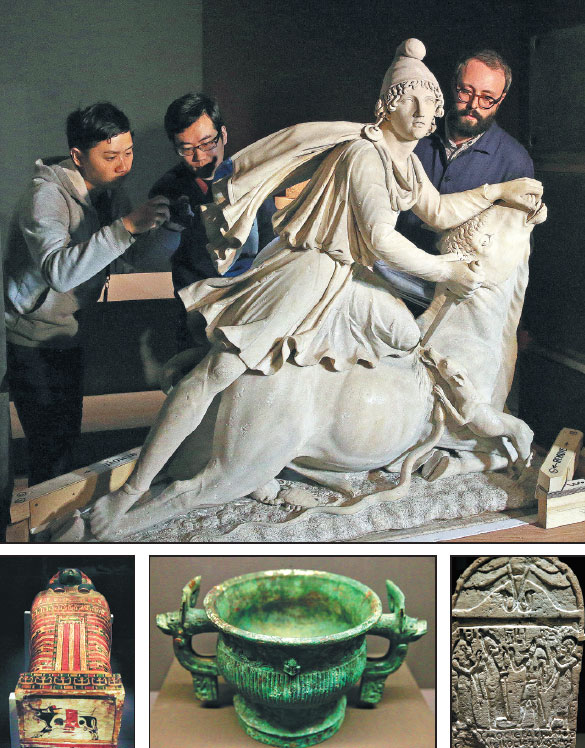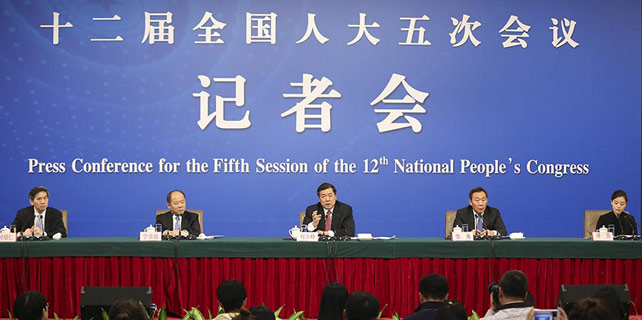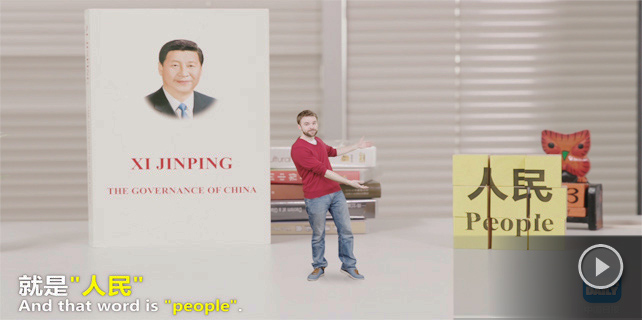Treat for museum fans
The much acclaimed exhibition, A History of the World in 100 Objects, is currently on at Beijing's National Museum of China. And it features a few Chinese treasures as well. Lin Qi reports.
Since it started a global tour in 2014, the widely commended exhibition A History of the World in 100 Objects has attracted more than 1 million visitors in cities including Abu Dhabi, Tokyo and Canberra.
The exhibition, which evolved from a radio program jointly produced by the British Museum and British Broadcasting Corporation in 2010, is currently on at Beijing's National Museum of China, and is causing quite a stir.
Nine Chinese objects, including a 3,000-year-old bronze ritual vessel and a Yuan Dynasty (1271-1368) blue-and-white plate, are on show, although there is a disappointment about the absence of the Admonitions Scroll, a precious 6th-century Chinese painting, which was featured in the radio program.
The 100-episode radio series introduced one object from the London museum's collection in each show and navigated innovations in art, technology and industry spanning different cultures, over the course of 2 million years of human history.

When it was first broadcast, the program was followed by 11 million listeners. And now, you can download the broadcasts from a website devoted to the project.
Hartwig Fischer, the German director of the British Museum, says the exhibition shows forces that pushed humans beyond the horizon of Africa, and it shows that globalization is a "powerful development" and "a process that can not be turned back or halted".
He says it is "wonderful" for the London museum to be able to share such a global collection, ranging from the inner coffin of Egyptian king Shepenmehyt from 600 BC to a solar-power lamp and charger produced in Shenzhen, China, in 2010.
"The British Museum is a museum of the world, and for the world. We are the biggest lender among all big museums. We have profited from globalization and we are a dynamic factor in the process. This is what we want to continue," says Fischer.
Some of the objects from the original exhibition have been changed because a lot of things featured in the original radio series are too fragile to be moved or even put on display in galleries, says Belinda Crerar, the British Museum's curator of the exhibition.
"We want to keep it (the touring exhibition) as close to the original series as possible, but sometimes an object can not be displayed for conservation reasons, and at other times it is because of the huge scale (of objects)," she tells China Daily.
"So, we try to look for objects in the collection, which can maintain the narrative of the original series. In some cases, when that is not possible, we have added new objects and new stories."
The absence of the Admonitions Scroll is due to the fragile condition of its silk support and its cracked paint. Also missing from the Beijing show is The Great Wave, an iconic work by Japanese artist Katsushika Hokusai (1760-1849) who is known for his ukiyo-e paintings and wood block prints. It was part of the original radio program.
The British Museum has three copies of the print. But Crerar says that the three pieces on paper can be displayed for a very limited period - two years in every decade - and for the rest of the time, they have to be kept in a dark area so that they do not get bleached.
"Unfortunately, when we prepared for the tour, the three copies had been on tour or in various exhibitions, so we could not include any of them, which is very disappointing," she says.
The replacement is a set of Hokusai's manga books, which Crerar says is a very nice addition to the exhibition because it provides depth on European-Japanese exchanges. She says the books were incredibly popular in Europe and influenced a lot of European impressionist artists who picked up various aspects of Hokusai's style.
When it tours, the exhibition features a 101st object, which the host museums provide and is pertinent to local audiences. The Beijing leg features a wooden hammer and a pen used to mark China's entry into the World Trade Organization in 2001.
The exhibition will travel to the Shanghai Museum in June, and the museum is inviting suggestions on what the 101st object should be.
Crerar says when viewers compare objects representing different cultures, they will find similarities in many cases. "What it (the exhibition) showcases are universal concerns and the needs of humanity that are manifested in different parts of the world, in different times, but in a very similar way."
Yan Zhi, the exhibition's co-curator from the National Museum of China, says the format of A History of the World series inspired Chinese museum curators in terms of how to make use of their collections, and how to use digital technology to better communicate with the public.
Fischer says the exhibition is a tangible highlight in a long-standing relationship between the two museums, which they hope to continue.
Crerar says there were around 7 million visitors to the British Museum in 2016 and about 5 percent were Chinese, which she calls "a significant proportion".
The British Museum provides guide books and tours in Chinese, and has a Chinese language website and a WeChat account.
Chen Chengjun, deputy director of the National Museum of China, says that a catalog of Chinese artifacts in the British Museum is being compiled. He says that images of the featured objects have been finalized and Chinese and British experts are working on the text. He hopes that the volume will be published within the year.
The volume will be the third in an ongoing publishing project called Selected Ancient Chinese Objects in Overseas Museums.
The National Museum of China reaches out to leading museums worldwide not only for exhibitions of the collections, but also to collaborate with them on the publishing project.
It launched the first book on cultural relics in London's Victoria and Albert Museum in 2014, and a second one about the Chinese collection at Japan's Sen-oku Hakuko Kan Museum in 2016.
Contact the writer at linqi@chinadaily.com.cn
If you go
9 am-5 pm, closed on Mondays, through May 31. 16 East Chang'an Avenue, Dongcheng district, Beijing. 010-6511-6400.
|
Clockwise from top: A marble statue of Mithras slaying the bull; a funerary stela of Didymos from Egypt; a 3,000yearold Chinese bronze ritual vessel; an inner coffin of Seshepenmehyt of ancient Egypt. The British Museum collections are shown at the Beijing leg of A History of the World in 100 Objects. Photos By Jiang Dong / China Daily |
(China Daily USA 03/07/2017 page8)

















